| Patrick Bartholomew is the owner of the London Piercing Clinic in London, England. The following interview was conducted via email in January 1997. Patrick may be reached via email at master.patrick@cableinet.co.uk |
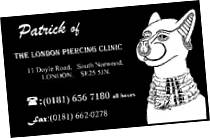
|
No, not really, the law simply insists that what one is doing is a form of artistic expression, and not a sadomasochistic sexually deviant experience. We have not had a prosecution to my knowledge.
BME: I was under the impression that it was the GBH laws that caused Mr. Sebastian so much trouble?
No, they were tied into the sexual S&M side of it all, and that is illegal, apart from the case in question being a serious bit of Gay Bashing by the police.
BME: Genesis P-Orridge claims to have been essentially exiled due to these laws -- There's an interview online where he makes these claims.
Gen is a luverly guy, but I do know him a bit better than the person interviewing him, it is not all as it says, just the same he got a bum deal.
As far as legislation goes, at this stage I am not sure of the direction that they will finally go... there is talk of making all genital piercing illegal.
If they do I will become very rich over night. Driving it underground will only increase demand, and I would employ a full time doctor to give me legal status. My own input is to set up a 142 hour training course over 4 weeks including the use of all commonly used methods, medical training for the treatment of shock, haemorrhaging and use of local anaesthetic. This would include a tough written and practical examination conducted by the Environmental Health Dept. Hopefully they will listen.
BME: Wow. That would give England by far the most medically educated piercers. Who would determine what training is required?
Me hopefully!
We are a lot more sophisticated in our attitudes towards sex and eccentricity, the North American attitudes are far more naive. It is only in the Gay Scene that this seems to even out. We also seem to have less restrictive laws that may account for our willingness to experiment. I still think that the North American piercers are generally very good, but they do rather shout about their 'new' piercings too soon. Long before they have proven their 'new advances' thoroughly.
BME: Yes, I've noticed that -- When new procedures come out here, one generally hears about them within a couple of months, whereas I've noticed that when you send me pictures of what would be considered quite radical here, the dates on it put it back often nearly a decade!
One success does not make a revolution, and there is still too much bull-shit mixed in with the fact. Many 'newbies' try to make up for their lack of ability with sensational sounding crap that even they begin to believe in the end.
 
|
I never honestly thought of them as being different when I did them. The old adage of: "If it Dangles or Protrudes then Pierce IT!" was all that occurred to me back then. As you say they was no danger involved.
BME: To the extent that you can say, how is the UK scene different than the North American scene?
From the media one has the impression that the average American Piercer is an anti-social, sadistic, ignorant, drug abusing, self destructive, weird cultist sociopath. I know that this is as far from the truth as the Marihuana Laws, but mud sticks. Because of the sensational publicity and the rise of the Modern Primitives movement in the USA the average British piercer tends to shy away from this image like the plague, and they are, to a large extent, fairly conservative in their work and their publicity. There are the exceptions, mainly amongst the good ones.
BME: I've noticed also that UK piercers, at least the ones that have made it into the North American media, are also much older -- Many high profile piercers here are only in their early twenties, and have only been piercing for a few years.
The American public are much more trusting than the conservative British, they expect you to have about 150 years of experience before they drop their trousers here.
BME: You estimated that you've done about 36,000 piercings?
Yes, I average about 4,000 piercings a year these days.
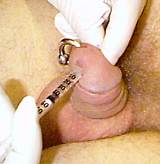 BME: Are piercings there almost universally performed under a
local?
BME: Are piercings there almost universally performed under a
local?
No, very few.
BME: Oh. Is it only when the client requests it?
No, very few piercers here have legal access to it and also lack the training and skill to treat anaphylactic shock.
You have to be a nurse or in legal possession of the anaesthetic, work under the direction of a doctor and have the necessary resuscitation equipment available.
"Legal possession" is very vague, but if a doctor gives it to you, you are in legal possession. My own credentials are sufficient to use it, apart from the fact that I have three doctors as very close friends whom I can call upon at any time.
BME: Most piercers in North America speak very negatively of
anaesthesia, citing...
|
...the possibility that the anaesthesia deforms the tissue,
resulting in a crooked piercing.
|
|
...medical safety risks (allergic/chemical reaction, or
frostbite in the case of a spray anaesthetic.
|
|
...that it takes away from the ritual of the experience if you
can't feel it.
|
BME: So it's almost a matter of not mixing business and pleasure?
I never do unless it is a consentual S&M scene. On a recent Sunday night I did a pair of labia piercings -- the young lady was attached to my rack, and, in fact I inserted the rings without a needle or pin, just pushing hard through, quickly without anaesthetic. The lady in question was ecstatic about the experience. I had problems getting her off my neck for the rest of the evening.
BME: To a great number of people, the pain is a part of the transformative power of body art -- So is that not really an option for them then? Is this due in part to GBH laws?
For them yes - for me "Nope", I just don't get off on the pain of some one pushing bloody great spikes through me, and nor do most of my clients either. Mr Sebastian once did a tattoo for me under local anaesthetic (remembering he too was an S&M Master), I love it no less because it was totally painless. In fact I treasure it most of all my tattoos, because it was done with his love.
The technique is fairly simple, but it has variations for each piercing. Firstly I prep the skin with alcohol. Next I mark up with a very fine gentian violet marker pen. Then, using a fine 1ml insulin syringe, I administer the anaesthetic. (From about .2ml for a nose, eyebrow or ear, up to 1.0ml for an ampallang and clitoris. 0.5ml for navel, nipples, p/a, guiche, clit hood and hafadas etc. the tongue is 0.4ml as is the labia). I prefer dental lignocain with the small trace of adrenaline it comes with. (I also use prilocain with octapressin where allergies may occur). After a two minute wait I insert the thin guide needle. This is usually 14ga. (eyebrow, tragus and nose it is 18ga). I then assess the accuracy of the piercing, and if corrections are needed I make them. Once I am satisfied with the positioning of the guide needle I insert a tapered insertion pin of the same diameter as the jewellery I am inserting. The insertion pin has a rear recess that positively accepts the end of the ring or barbell. I firmly and smoothly push the jewellery in behind the pin. Once the jewellery is straightened, I cover with a dry dressing.
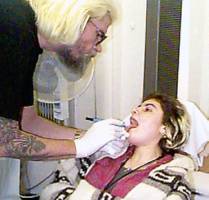 There is rarely any bleeding due to the adrenaline in the anaesthetic,
and due to the small primary hole which is stretched up to the jewellery.
This pulls back tight onto the ring or bar once it is in place. If I am
doing a PA, I prefer to use an internal guide tube (ID of 3mm) and
pierce from the outside to inside. I insert the tip of the tapered
insertion pin into the tip of the hollow guide needle and I then push
back through the piercing. Finally the 12ga titanium ring (of between
5/8th of an inch through to 7/8th of an inch) is pushed into place from
the inside to outside. Most of the straight through piercing I do with a
solid needle, I only use hollow needles when a change of direction is
needed, i.e.: a labret etc.
There is rarely any bleeding due to the adrenaline in the anaesthetic,
and due to the small primary hole which is stretched up to the jewellery.
This pulls back tight onto the ring or bar once it is in place. If I am
doing a PA, I prefer to use an internal guide tube (ID of 3mm) and
pierce from the outside to inside. I insert the tip of the tapered
insertion pin into the tip of the hollow guide needle and I then push
back through the piercing. Finally the 12ga titanium ring (of between
5/8th of an inch through to 7/8th of an inch) is pushed into place from
the inside to outside. Most of the straight through piercing I do with a
solid needle, I only use hollow needles when a change of direction is
needed, i.e.: a labret etc.
I do the piercings between my gloved fingers, (this can be very! very! very! dangerous! needle stick injuries are guaranteed if you do not know what you are doing and are not concentrating 100% on all cylinders. And the needles must be sharper than the manufacturers make them. Much Sharper!). I get no bruising nor skin distortion working like this.
BME: Do you ever use clamps?
Yes, very occasionally, usually only when I am doing inverted nipples, they do help. Also when I do skin cutting I usually clamp the site with mosquito forceps to expel blood from the cutting site for about five minutes, then I remove them and cut along the perfectly created mark.
I prefer to use short blunt nosed surgical scissors for most skin cutting, a scalpel is low on my choice of favourite tools. But I use what ever works best.
BME: Do you ever get bleeding?
Yes, especially with cutting, but any piercing can bleed if you nick a blood vessel. To stop it I administer 3 drops orally of a homeopathic remedy of arnica, ipecac and traumeel that my Homeopath friend makes up for me. It works a treat on small bleeds. On the more serious ones I use the cauteriser, that works on almost any bleeding I am likely to encounter in what I am doing.
I also use cynoacrilate Super Glue in conjunction with sutures when closing an implant wound -- A method we successfully used when I was in the Army. I had a deep slash down the inside of my left forearm (due to a very frightened injured cat I was putting back together in the middle of the night some years ago), I only used the super glue on this, and today it is almost invisible.
BME: Do you ever have a client go into shock?
Yes, but usually very mild, I normally supply glucose enriched drinks when it happens, and follow accepted 1st aid shock procedure treatment. (Yes - I do ascertain from all clients any information relating to allergies or medical problems before I start working on them, if I am not sure I call in a doctor friend of mine from next door).
The worst cases occur usually in spectators, not the piercee's. Many is the big guy I have peeled off the clinic floor, the poor fellow feeling a complete fool as he comes around. This is not some thing people have much control over, and I am usually pretty sympathetic.
BME: What sort of emergency equipment do you have on hand?
Adrenaline to treat anaphylactic shock (I have never needed it, but I keep up to date supplies at hand). Oxygen, an Ambi Bag resuscitator, (again used once on a spectator), a comprehensive first aid kit and two halon extinguishers.
I also have a powerful emergency light above my dental couch in case of a power failure, (It has happened once when a utility company went through a main electric cable outside my premises) and a powerful rechargeable torch on permanent charge.
I also have a written emergency procedure for each foreseeable situation, and all staff, are fully conversant with the procedures. I can not stress strongly enough the safety of the entire operation.
BME: What do you do about sterilization?
I work in a semi-sterile field (no air control), with proper scrubbing up procedures. I do not usually wear protective clothing, I change my 'T' shirt several times a day - especially in summer.
What is not disposable is cleaned in an ultrasonic cleaner with an alcohol/ Phoraid mixture for 60 minutes, visually inspected, and then it is autoclaved.
My autoclaves are on a maintenance contract which ensures full testing every 4 months. All clinical waste and sharps are collected by a contractor for safe disposal.
BME: Do you believe that you can improve your methods at all?
Not really, I have reached what I consider to be as high a level of development as I can, and as for my techniques, they are better than adequate.
Let me include Gold in my list of NO-No's along with Stainless. It too is too impure by my standards. I always felt that it was a race between healing and rejection with 316 Stainless steel. All too often piercings 'walked' during this period, and shrinkage was a constant problem. Some thing I still see with Gold.
The reason we stay away from stainless is due to nickel allergies. There is a EEC directive coming out preventing the use of Stainless in fresh piercings, weather Britain will accept or follow it is a moot point. I certainly will encourage it.
BME: What's an EEC directive? (I don't know what EEC stands for).
Sorry, The EEC is the 'European Parliament' based in Brussels who decide what constitutes an Eccles cake or a Champagne (is it a recipe or a regional product -- most of it is an utter waste of effing time, but occasionally they get it right.)
I like Niobium as much as I do titanium, but at $3 to me for a navel ring in titanium Vs $10 for an American Niobium equivalent, guess which one wins?
BME: One of the tools that you use in your art is a cauteriser -- Could you tell me exactly what this is?
It is a variable control transformer with a silver alloy electrode that heats up to white hot. It is generally used for sealing off blood vessels and removal of warts etc.
About ten years ago I walked into a medical supply company and bought one across the counter. No one queried me about it at all. As for using one, I used them when I was an Army Medic, I never thought twice about its use or results, it just happened and I have been right from Day One.
It is not illegal to posses the equipment at all, (nor is it illegal to posses marijuana seeds here, it only becomes a crime when you plant them). ?????
It is a grey area. We don't have a written constitution, and much of the law is based on legal precedent, much of which conflicts with other precedents -- it is down to who is the Judge on the day really, I am not enamoured with the system at all, but it has its good points compared to some of the North American State Laws, many of which sound like they were written in the dark days of the Spanish Inquisition.
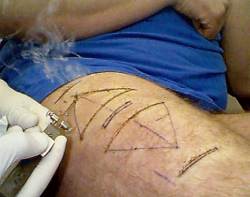
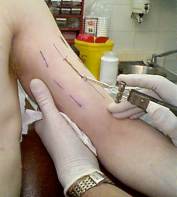
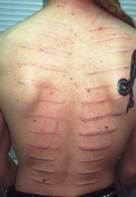
|
I find it to be more accurate, the depth is easier to control and as for pain, I do it under anaesthetic most of the time. When done without, it is no worse than a 'strike' using a heated piece of metal.
BME: Does using the cauteriser affect the "ritual" or "spiritual" aspect of a brand that many people find very important?
I am sorry if I can not take this aspect very seriously. I would be bloody worried if I went to a doctor and he told me to bite on a piece of leather while he stitched me, or if he did a small war dance between taking my temperature and checking my blood pressure.
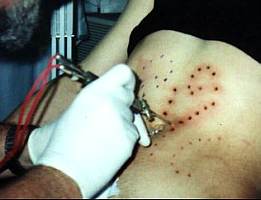 BME: Crudelia's branding was a ritual event though, correct?
BME: Crudelia's branding was a ritual event though, correct?
I went along with it for his sake, he is a great friend, but all religious guff depends on the two words "I believe...." and if you don't then ......?
BME: The cauteriser also has some applications in piercing -- Tell me a bit about how you have used the cauteriser to perform large ear cartilage piercings. How does it affect healing, end result, etc?
All too often people expect too much too soon -- this is on the front page of my after care pamphlet. With ear lobe stretching this is 99% the case! In Zululand, the place of my birth, a young tribal man would probably pierce his lobes at about age thirteen. It was only by age twenty that he had stretched it up sufficiently enough to fit the 30mm wide plugs into the piercings. Sadly one very seldom sees them anymore, the wearers are seen as being parochial country bumpkins.
BME: In my case it's been about five years of on and off stretching to get me to 50mm... But there are at most three years of active stretching in that. However, due to a placement that was adequately high, I've had no problems.
SO very few do place the initial hole properly. What I get to see is people putting large quantities of wires into piercings as quickly as possible, resulting in the skin at the bottom of the lobe becoming very thin and finally snapping. This happened to Jason, and the two little resulting 'penises' finally shrivelled away, and I put in his present flesh tunnel to even up the size of the lobes. The major problem with stretching a lobe-piercing is the initial piercing should not be located in the middle of the lobe, but rather as high up as possible to the ear shell. If this is not done, I find the cauteriser works wonders in correcting the problem before it is too late. I cauterise upwards and fit a 7mm OD flesh tunnel straight into the hole. When doing the inner shell of the ear it is exactly the same, it is easier if there has been a piercing hole from which to start, but it is not particularly difficult all the same. Healing is not too bad, provided it is kept clean, and not abused, it heals perfectly within 5 months on average.
Its great advantage is the lack of bleeding whilst it is being done. The last one took about 30 minutes of actual work, realising that I go very very slowly when dealing with anything close to the corpus cavernosum. I find it hard to explain things to some one who has no formal medical training, but as far as safety is concerned I feel that 99% of my safety precautions revolve around one thing only -- caution, just being F#@*ing careful. The basic healing is about ten days, full heal about two months.
BME: How far could you take this bifurcation in one go? I know a subincision can be done in one step, but what about a bifurcation?
I believe that it would take me about three hours to complete the entire penis. And I see no reason why it should not be done in one go. Though I did it in three goes the last time I did it. Two weeks between sessions. This was about six years ago.
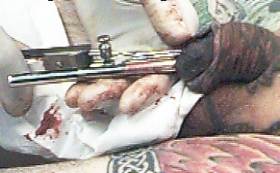
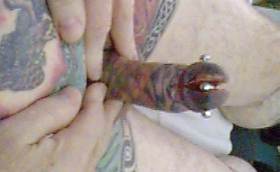
|
In the UK provided you are not claiming to be healing someone, you do not need a license to perform cosmetic surgery, provided you have your client's consent. This is in the process of being changed, but as of yet has not. As for legal risk, litigation has no hope in hell of success in a British Court if you consented to letting a piercer work on you in the first place. If you could prove wilful negligence you may be in with a chance, but that is almost impossible to get right. The courts work on the basis that you must have been bloody mad to consider it in the first place, and it is seen as being 'self inflicted'.
BME: So how does a client protect themselves? Is it basically a matter of educating themselves as best they can and making an informed choice of piercers?
Most definitely -- until proper evaluation/legislation can be introduced.
It happened about seven years ago, but I get asked for about four or five a year these days.
BME: Can you talk a bit about your experiences with implants?
I have had about a 50% failure rate, mainly due to premature abuse. Also if I put more than one bead in at a time the odds of rejection increase enormously.
BME: You mention that you do beading using hematite balls, rather than the titanium and Teflon favoured by some others. Why hematite?
It was available cheaply with a hole (for securing with a stitch inside the wound), and it is pretty well hypoallergenic.
BME: Did you find that it was important to secure the hematite? What happens if you don't?
It helps, but loose surrounding skin makes all the difference really.
BME:How are you implanting them? Using the taper method, basically like a piercing, or some other method?
No, I cut a slit about 6mm long following the grain of the skin. I then make a pocket about 10mm in under the skin in the membrane, I put a shallow stitch in the bottom of the pocket and pull the suture through the 8mm bead. Next I use the end of an insertion needle to place the bead into the pocket where I tie off the suture. Finally I stitch up the wound with three small stitches.
In 1988 I was asked by a Gay Magazine where piercing would take me by the turn of the century, and my flippant reply was "God knows, I am more interested in where I will take Piercing!" That has been my philosophy throughout, and I only hope that it has been along a true and righteous path. I always believed that I would have an influence, and now that I look back I feel proud of what I have done and achieved, and Like Mr Sebastian before me:I hope I will be remembered not mainly for my piercings - my art, but for my ethics, for my refusal to compromise on my standards and beliefs, for my methods and my concern, and for my sincere empathy for my clients.